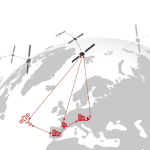The Federal Railroad Administration (FRA) last week released a status update that calls for railroads to roll out Positive Train Control (PTC) technologies, which incorporates GNSS technology, as soon as possible. The update also underscores the Obama administration’s calls to provide more funding to assist commuter railroads in implementing PTC.
PTC uses GNSS, but mostly GPS, to prevent train-to-train collisions, high-speed derailments, and the unauthorized movement of trains into work zones.
The Federal Railroad Administration (FRA) last week released a status update that calls for railroads to roll out Positive Train Control (PTC) technologies, which incorporates GNSS technology, as soon as possible. The update also underscores the Obama administration’s calls to provide more funding to assist commuter railroads in implementing PTC.
PTC uses GNSS, but mostly GPS, to prevent train-to-train collisions, high-speed derailments, and the unauthorized movement of trains into work zones.
As Inside GNSS reported last November, the Surface Transportation Extension Act of 2015, signed by President Obama on November 20, postponed from December 31, 2015, to December 31, 2018, the deadline for Class I railroads to submit a revised plan for implementing a positive train control (PTC) system on certain of their tracks. The measure further allowed carriers to file an alternative schedule and sequence for implementing a PTC system, subject to Department of Transportation review, that could delay implementation until 2020.
The FRA’s status update includes railroad-by-railroad quarterly data as of June 30, 2016. The report also includes on-track segments completed, employees trained, radio towers installed, route miles in PTC operation, and other key implementation data. In March, FRA said that it intended to require railroads to submit quarterly PTC implementation progress reports to the agency.
Congress, Train Industry Slow to Accept PTC
Both U.S. Transportation Secretary Anthony Foxx and FRA Administrator Sarah Feinberg have called for quicker implementation of PTC by the railroad industry. In addition, the National Transportation Safety Adminstration (NTSB) also recommended GPS-aided positive train control (PTC) as one of its “most wanted” transportation safety improvements in 2016.
But NTSB, which has been advocating for PTC for more than 45 years, appears to be fighting an uphill battle against Congress and the railroad industry.
At January’s Transportation Research Board’s Annual Meeting in Washington, D.C., NTSB Chairman Christopher Hart lamented the railroad industry’s failure to meet the 2015 deadline set seven years ago for PTC implementation.
The limit on liability to passenger railroads also could be a factor hampering quick PTC rollout. Last year, Amtrak’s liability for the Philadelphia accident was capped at $200 million by Congress, which attorneys representing railroad victims say is inadequate, according to published reports.
“This may well be the most logical reason. If the liability is capped, why spend the money?” said Alain Kornhauser, Princeton University professor and director of the school’s transportation program.
Another reason for slow implementation is that PTC, as it is currently defined, may be obsolete, cumbersome, and expensive in its design, Kornhauser said. “The regulations don’t have the flexibility to leapfrog design,” he said. “There has been enormous technological advancement and design stuck by regulations. There is little incentive for the railroads to be creative. By limiting liability, there is little incentive to improve the working conditions of train engineers, labor productivity, or reducing labor cost.”
Although PTC reduces the dependence on train engineers and opens the door for fully automated trains, Kornhauser doesn’t believe that this is a union issue. “If one compares driverless cars with engineerless trains, in many ways it is much easier to do [engineerless] trains because much of what a train engineer does is to react to cab signals that are activated by an external signal system,” he said. “In such cases, the engineer is simply reacting to an electronic signal in applying the brake and the throttle. It is so ‘off the shelf’ that essentially all new subways are being built a so-called unattended train operation (UTO) and that is for underground train operation where GPS is not available. Above ground it is even easier.”
Since Congress set the PTC deadline in the Railroad Safety Improvement Act of 2008, the NTSB has investigated a long list of railroad accidents that would have been prevented by PTC. Most recently, these included the May 12, 2015, Amtrak derailment in Philadelphia, Pennsylvania, that killed eight and injured more than 200, as well as the December 1, 2013, Metro-North passenger train derailment in the Bronx, New York, that killed four and injured 61.
The NTSB should not have listed the train’s engineer as its first cause of the Philadelphia derailment, Kornhauser said.
“It should have been Amtrak’s failure to implement some form of PTC on that section of track. Physics clearly specifies a speed limit for each section of track,” he said. “It is trivial to know on which section of track it is traveling — and it is trivial to automatically control the speed of a train. It should not be the responsibility of the train engineer to ensure that a train does not violate physics’ speed limits. Something which is essentially trivial for today’s automated control systems.”
Feds Making PTC a Priority
Despite concerns from the railroad industry about PTC implementation costs, FRA this month awarded nearly $25 million in grants to help implement the technology. This follows the U.S. Transportation Department’s (DOT) July announcement that commuter railroads and states can apply for $199 million in PTC implementation grants.
In his Fiscal Year (FY) 2017 budget request, the Obama administration requested $1.25 billion for PTC implementation. This follows requests of $825 million in both FY 2015 and FY 2016.






